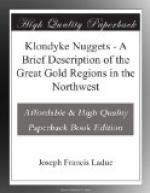“Where the river debouches from it, it is about 150 yards wide, and for a short distance not more than 5 or 6 feet deep. The depth is, however, soon increased to 10 feet or more, and so continues down to what Schwatka calls Marsh Lake. The miners call it Mud Lake, but on this name they do not appear to be agreed, many of them calling the lower part of Tagish or Bove Lake “Mud Lake,” on account of its shallowness and flat muddy shores, as seen along the west side, the side nearly always travelled, as it is more sheltered from the prevailing southerly winds. The term “Mud Lake” is, however, not applicable to this lake, as only a comparatively small part of it is shallow or muddy; and it is nearly as inapplicable to Marsh Lake, as the latter is not markedly muddy along the west side, and from the appearance of the east shore one would not judge it to be so, as the banks appear to be high and gravelly.
“Marsh Lake is a little over nineteen miles long, and averages about two miles in width. I tried to determine the width of it as I went along with my survey, by taking azimuths of points on the eastern shore from different stations of the survey; but in only one case did I succeed, as there were no prominent marks on that shore which could be identified from more than one place. The piece of river connecting Tagish and Marsh Lakes is about five miles long, and averages 150 to 200 yards in width, and, as already mentioned, is deep, except for a short distance at the head. On it are situated the only Indian houses to be found in the interior with any pretension to skill in construction. They show much more labor and imitativeness than one knowing anything about the Indian in his native state would expect. The plan is evidently taken from the Indian houses on the coast, which appear to me to be a poor copy of the houses which the Hudson’s Bay Company’s servants build around their trading posts. These houses do not appear to have been used for some time past, and are almost in ruins. The Tagish Indians are now generally on the coast, as they find it much easier to live there than in their own country. As a matter of fact, what they make in their own country is taken from them by the Coast Indians, so that there is little inducement for them to remain.
“The Lewes River, where it leaves Marsh Lake, is about 200 yards wide, and averages this width as far as the canon. I did not try to find bottom anywhere as I went along, except where I had reason to think it shallow, and there I always tried with my paddle. I did not anywhere find bottom with this, which shows that there is no part of this stretch of the river with less than six feet of water at medium height, at which stage it appeared to me the river was at that time.
“From the head of Lake Bennet to the canon the corrected distance is ninety-five miles, all of which is navigable for boats drawing 5 feet or more. Add to this the westerly arm of Lake Bennet, and the Takone or Windy Arm of Tagish Lake, each about fifteen miles in length, and the Taku Arm of the latter lake, of unknown length, but probably not less than thirty miles, and we have a stretch of water of upwards of one hundred miles in length, all easily navigable; and, as has been pointed out, easily connected with Taiya Inlet through the White Pass.




